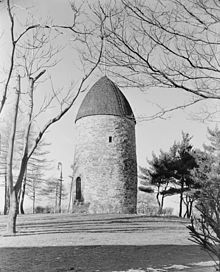Powder alarm
The powder alarm ( Gunpowder alarm ) was a massive public reaction in the British colony of Massachusetts on a surprise attack British troops under the command of General Thomas Gage . He was the Royal British Governor of Massachusetts before the American War of Independence . On September 1, 1774 , British soldiers seized gunpowder and other military supplies in a surprise attack near Boston. This venture worried the rural population, fearful of the imminent outbreak of civil war, and the American Patriot group stepped into action. Although everything soon turned out to be a false alarm, the powder alarm led to all those involved making preparations in the period that followed. So the Powder Alarm became a kind of dress rehearsal for the battles in Lexington and Concord seven months later.
The expedition
General Gage was responsible for implementing some highly unpopular laws known as the Intolerable Acts . At the same time he wanted to prevent the outbreak of war between the majority of the American Patriot Party (Whigs) and the minority of Loyalists (Tories) loyal to Great Britain . He believed he could do this by seizing military supplies that were being stored in Massachusetts.
Early on the morning of September 1, 1774, a unit of about 260 British regulars crossed the Mystic River near Boston and landed near Winter Hill in what is now Somerville. At that time, this area was part of Charlestown . From there they marched about a mile to the Powder House (powder house) in what is now Powder House Square. This was where the largest supply of gunpowder in Massachusetts was stored. The county sheriff gave the royal soldiers the keys to the building, and they took all the gunpowder with them after sunrise. Most of the British soldiers then returned to Boston the same way. A small contingent marched to Cambridge , took two field cannons with them, and walked back over the great bridge to Boston.
reaction
This success prompted the march of tens of thousands of militiamen to Boston, which was broken off. Many of them came from towns and cities outside of Massachusetts in the other provinces of New England . They had heard false rumors of armed conflict and continued British troop movements. After receiving correct information, these militia units returned home. An angry crowd of patriots drove some loyalists out of Cambridge and forced the sheriff who had given the keys to the British to swear an oath never to enforce the Intolerable Acts or obey orders from Gage.
The angry response from the population took Gage by surprise and failed to take a second similar action. Gage concentrated his troops in Boston and called for reinforcements in London.
consequences
After the Powder Alert, the Massachusetts militia sought to conceal their supplies and stepped up their efforts to obtain information on Gage's plans and troop movements. Here played Paul Revere , an important role because he came from Boston, as a craftsman of the middle class had a number of contacts with all walks of life and he was a well-known recruiter and organizer for the patriotic cause.
On September 21, 1774, Patriot leaders from all over New England met in Worcester . They decided to persuade the local assemblies to divide a third of the militia officers into special companies that should be operational within a very short time. These were called the minutemen . In addition, a message system should be formed from fast tabs and signals. This was an important factor in the later battles in Lexington and Concord. In October, the former Massachusetts Provincial Assembly met to protest the Massachusetts Government Act and declared itself the First Provincial Congress. A security committee was formed, based on a model of the same name from the English Civil War .
They had supplies of powder removed from forts in Newport, Rhode Island, Providence and New London. Both loyalists and patriots claimed ownership of this powder. This was then distributed to the domestic militias. One of these actions resulted in a brief gun battle on September 15 at Fort William and Mary in Portsmouth, New Hampshire, with the six British soldiers stationed there. No one was seriously injured, however, and the militias occupied the fort. Its supplies were also removed.
On Sunday, February 27, 1775 , a detachment of about 240 British soldiers was sent to Salem to confiscate weapons. They were stopped by a small crowd that overtook a drawbridge on the way and mocked them. Meanwhile, others brought the cannon to safety and asked for help from nearby towns. Eventually the drawbridge was lowered and the British Army was able to search the forge where the cannon had previously been. They returned to their ships under the mockery of the militiamen who marched beside them.
These bloodless confrontations over military supplies appeared to both those involved and historians in retrospect as an intermediate step that inevitably led to open conflict. It should be borne in mind, however, that the events leading up to the battles of Lexington and Concord on April 19, 1775 could have been just another harmless and bloodless powder alarm if they had not gotten out of hand in some key situations.
literature
- Fischer, David Hackett. Paul Revere's Ride . New York: Oxford University Press, 1994. ISBN 0195088476 .
- Raphael, Ray. The First American Revolution: Before Lexington and Concord . New York: The New Press, 2002.
